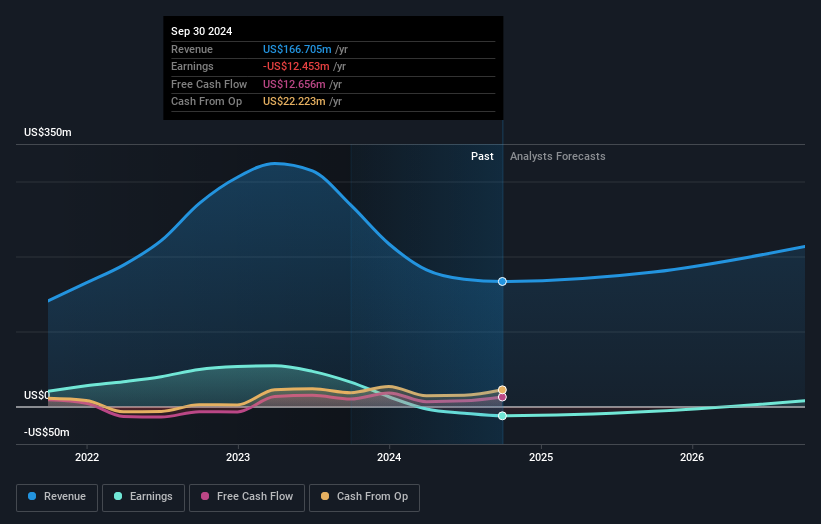- United States
- /
- Communications
- /
- NasdaqGM:CLFD
Clearfield, Inc.'s (NASDAQ:CLFD) large institutional owners must be happy as stock continues to impress, up 11% over the past week

Key Insights
- Given the large stake in the stock by institutions, Clearfield's stock price might be vulnerable to their trading decisions
- A total of 12 investors have a majority stake in the company with 51% ownership
- Recent purchases by insiders
If you want to know who really controls Clearfield, Inc. (NASDAQ:CLFD), then you'll have to look at the makeup of its share registry. And the group that holds the biggest piece of the pie are institutions with 63% ownership. In other words, the group stands to gain the most (or lose the most) from their investment into the company.
And as as result, institutional investors reaped the most rewards after the company's stock price gained 11% last week. The gains from last week would have further boosted the one-year return to shareholders which currently stand at 22%.
Let's take a closer look to see what the different types of shareholders can tell us about Clearfield.
Check out our latest analysis for Clearfield

What Does The Institutional Ownership Tell Us About Clearfield?
Institutions typically measure themselves against a benchmark when reporting to their own investors, so they often become more enthusiastic about a stock once it's included in a major index. We would expect most companies to have some institutions on the register, especially if they are growing.
As you can see, institutional investors have a fair amount of stake in Clearfield. This suggests some credibility amongst professional investors. But we can't rely on that fact alone since institutions make bad investments sometimes, just like everyone does. If multiple institutions change their view on a stock at the same time, you could see the share price drop fast. It's therefore worth looking at Clearfield's earnings history below. Of course, the future is what really matters.

Investors should note that institutions actually own more than half the company, so they can collectively wield significant power. Clearfield is not owned by hedge funds. Ronald Roth is currently the company's largest shareholder with 10% of shares outstanding. In comparison, the second and third largest shareholders hold about 7.3% and 6.7% of the stock. In addition, we found that Cheryl Beranek, the CEO has 3.3% of the shares allocated to their name.
After doing some more digging, we found that the top 12 have the combined ownership of 51% in the company, suggesting that no single shareholder has significant control over the company.
Researching institutional ownership is a good way to gauge and filter a stock's expected performance. The same can be achieved by studying analyst sentiments. There are plenty of analysts covering the stock, so it might be worth seeing what they are forecasting, too.
Insider Ownership Of Clearfield
While the precise definition of an insider can be subjective, almost everyone considers board members to be insiders. Company management run the business, but the CEO will answer to the board, even if he or she is a member of it.
Most consider insider ownership a positive because it can indicate the board is well aligned with other shareholders. However, on some occasions too much power is concentrated within this group.
Our most recent data indicates that insiders own a reasonable proportion of Clearfield, Inc.. It has a market capitalization of just US$500m, and insiders have US$84m worth of shares in their own names. We would say this shows alignment with shareholders, but it is worth noting that the company is still quite small; some insiders may have founded the business. You can click here to see if those insiders have been buying or selling.
General Public Ownership
The general public, who are usually individual investors, hold a 20% stake in Clearfield. This size of ownership, while considerable, may not be enough to change company policy if the decision is not in sync with other large shareholders.
Next Steps:
I find it very interesting to look at who exactly owns a company. But to truly gain insight, we need to consider other information, too.
Many find it useful to take an in depth look at how a company has performed in the past. You can access this detailed graph of past earnings, revenue and cash flow.
If you would prefer discover what analysts are predicting in terms of future growth, do not miss this free report on analyst forecasts.
NB: Figures in this article are calculated using data from the last twelve months, which refer to the 12-month period ending on the last date of the month the financial statement is dated. This may not be consistent with full year annual report figures.
New: AI Stock Screener & Alerts
Our new AI Stock Screener scans the market every day to uncover opportunities.
• Dividend Powerhouses (3%+ Yield)
• Undervalued Small Caps with Insider Buying
• High growth Tech and AI Companies
Or build your own from over 50 metrics.
Have feedback on this article? Concerned about the content? Get in touch with us directly. Alternatively, email editorial-team (at) simplywallst.com.
This article by Simply Wall St is general in nature. We provide commentary based on historical data and analyst forecasts only using an unbiased methodology and our articles are not intended to be financial advice. It does not constitute a recommendation to buy or sell any stock, and does not take account of your objectives, or your financial situation. We aim to bring you long-term focused analysis driven by fundamental data. Note that our analysis may not factor in the latest price-sensitive company announcements or qualitative material. Simply Wall St has no position in any stocks mentioned.
About NasdaqGM:CLFD
Clearfield
Manufactures and sells various fiber connectivity products in the United States and internationally.
Adequate balance sheet and overvalued.
Similar Companies
Market Insights
Community Narratives




